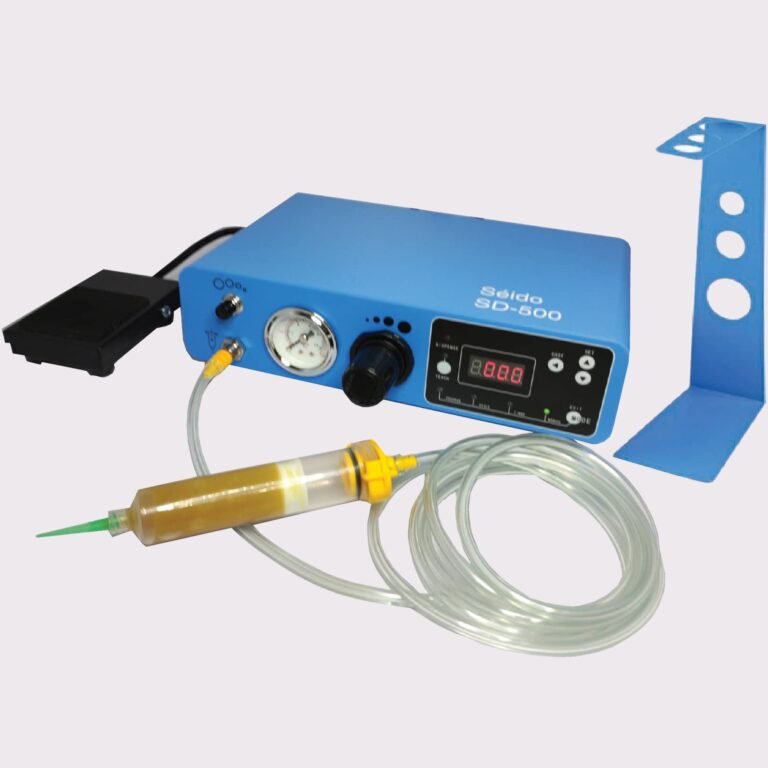In today’s fast‑moving manufacturing and assembly world, consistency and accuracy are non‑negotiable. That’s where an automated fluid dispensing machine comes into play — a system that precisely applies liquids (adhesives, sealants, fluxes, lubricants, solder pastes, etc.) in repeatable, reliable manner. At Sumitron, under the category of “Automated Liquid Dispensing Solutions” you’ll find equipment designed exactly for these industrial tasks.
For companies handling electronics, PCBs, pharmaceuticals, automotive components, industrial adhesives or any liquid material that must be applied in a controlled way, choosing the right dispensing machine can make a significant difference in production yield, material cost, quality and downtime.
Why Automation Matters
Automation in fluid dispensing revolutionizes manufacturing by ensuring consistent application, faster production, reduced waste, higher quality, and safer operations. Systems like Sumitron’s SD‑502 and dispensing robots provide precise, repeatable, and clean solutions, enhancing efficiency across electronics, automotive, and industrial processes.
Consistent Volume & Placement
Manual fluid application brings variability: operator skill, fatigue, timing, and environmental changes all affect results. An automated system ensures each dispense is identical — from volume to position to timing. For example, Sumitron lists a digital dispenser like the SD‑502 which offers digital control of time, pressure and vacuum to support stable, repeatable dispensing.
Speed & Throughput
When production lines run at high speed, manual dispensing becomes a bottleneck. Automated machines operate faster, can cycle continuously, handle multi‐head or multi‑valve setups and integrate with robotic systems or job changeovers. Within Sumitron’s “Dispensing Robots” category you’ll see automation applied for high resolution stepper motors and accurate linear guides.
Reduced Waste & Material Savings
Precise control means less over‑application, fewer rejects or rework, and better use of costly adhesives, sealants or fluids. The “Meter Mixing & Dispensing” category at Sumitron emphasises systems built for accuracy to ±1 % in sensitive industries.
Better Quality & Traceability
Automated systems can record dispense parameters, memory load programs, cycle modes, ensure correct recipe for each part, and support audit/tracking. The SD‑502 controller motif (39 memory locations, auto programme) is a good example.
Safety & Cleanliness
Fluid dispensing often involves adhesives, sealants or chemicals. Automation helps reduce operator exposure, dripping, splash, and environmental contamination. It also helps maintain clean manufacturing conditions — relevant especially in PCB, electronics, semiconductor or clean‑room applications.
Key Features to Look For
When selecting an automated fluid dispensing machine (or “automatic fluid dispensing machine” / “automated liquid dispensing machine” as you may search), consider the following features:
- Volume & flow control: Ability to set dispensing time, pressure, vacuum or flow rate precisely.
- Programme memory / automation modes: Store multiple jobs or setups; modes such as manual, timer, cycle.
- User interface & programmability: Digital display, teach mode, recipe loadings, job changeovers.
- Integration capability: Ability to link with robots, conveyors, pick‑and‑place machines, or other factory automation.
- Repeatability & accuracy: Especially for high‑volume or critical applications like electronics, pharmaceuticals or automotive.
- Fluid compatibility: Ability to handle adhesives, sealants, UV‑curable fluids, lubricants, low/high viscosity.
- Safety features: Leak detection, over‑pressure protection, drip prevention (suck‑back feature) etc. (Suck‑back is cited in SD‑500 unit. sumitron )
- Ease of maintenance & flexibility: Cartridge/barrel feed, changeable nozzles/valves, cleaning mode, modular setup.
- Support and service: From the supplier / distributor. At Sumitron, they mention customer support, ISO‑certified supply and logistics for Indian industry.
Use Cases & Industries
- Electronics & PCB assembly: Dispensing solder pastes, adhesives for components, underfill, thermal interface materials.
- - Automotive manufacturing: Sealants, adhesives for structural bonding, lubricants in assembly lines.
- - Medical & pharmaceutical: Precise dispensing of reagents, drugs, or fluid mixing in lab automation. (Sumitron’s “Meter Mixing & Dispensing” highlights dual‑pump systems for such applications.)
- - General industrial manufacturing: Assembly of appliances, packaging lines where adhesives/sealants must be applied.
- - Food & beverage / Consumer products: Dispensing flavorings, coatings, or other fluids where hygiene and accuracy matter.
Implementation Tips for Success
- Safety and training: Ensure operators understand handling, safety protocols, and machine setup.
- Define your fluid and process: Understand viscosity, cure time, required volume, dispense footprint, and environment.
- Select the right machine category: For simple single-valve dispensing, a basic digital dispenser may suffice. For complex patterns or high throughput, consider a robot or multi-valve system.
- Test with your real fluid: Always run trials with the actual material and substrate to validate accuracy, repeatability, and cycle time.
- Program and train: Build repeatable jobs and store them in memory.
- Optimize layout and flow: Integrate the machine into the production line logically — ensure feed, disposal, and changeover are efficient.
- Maintenance plan: Fluids can gum up nozzles or cause clogs, so ensure easy access for cleaning and spares.
- Monitor and adjust: Use data from dispensing cycles to refine volumes, flows, and detect drift or wear over time.
Choosing the Right Keyword & Content Strategy
For SEO purposes, the primary keyword is “automated fluid dispensing machine”, with related variations including “automatic fluid dispensing machine”, “automated liquid dispensing solution”, and “meter mixing & dispensing”. Using these keywords naturally in content ensures better reach to industrial buyers, engineers, and manufacturing managers searching for solutions.
Final Thoughts
Implementing an automated fluid dispensing machine is a strategic decision toward consistent quality, material savings, reduced waste, faster throughput, and better traceability. Whether in electronics assembly, automotive manufacturing, or high-precision lab automation, the right system can transform production processes. Consider factors like fluid type, required accuracy, throughput, integration, and support when choosing your machine. Investing in automation ensures efficiency, reliability, and long-term cost savings for any modern manufacturing operation.


Leave a Reply